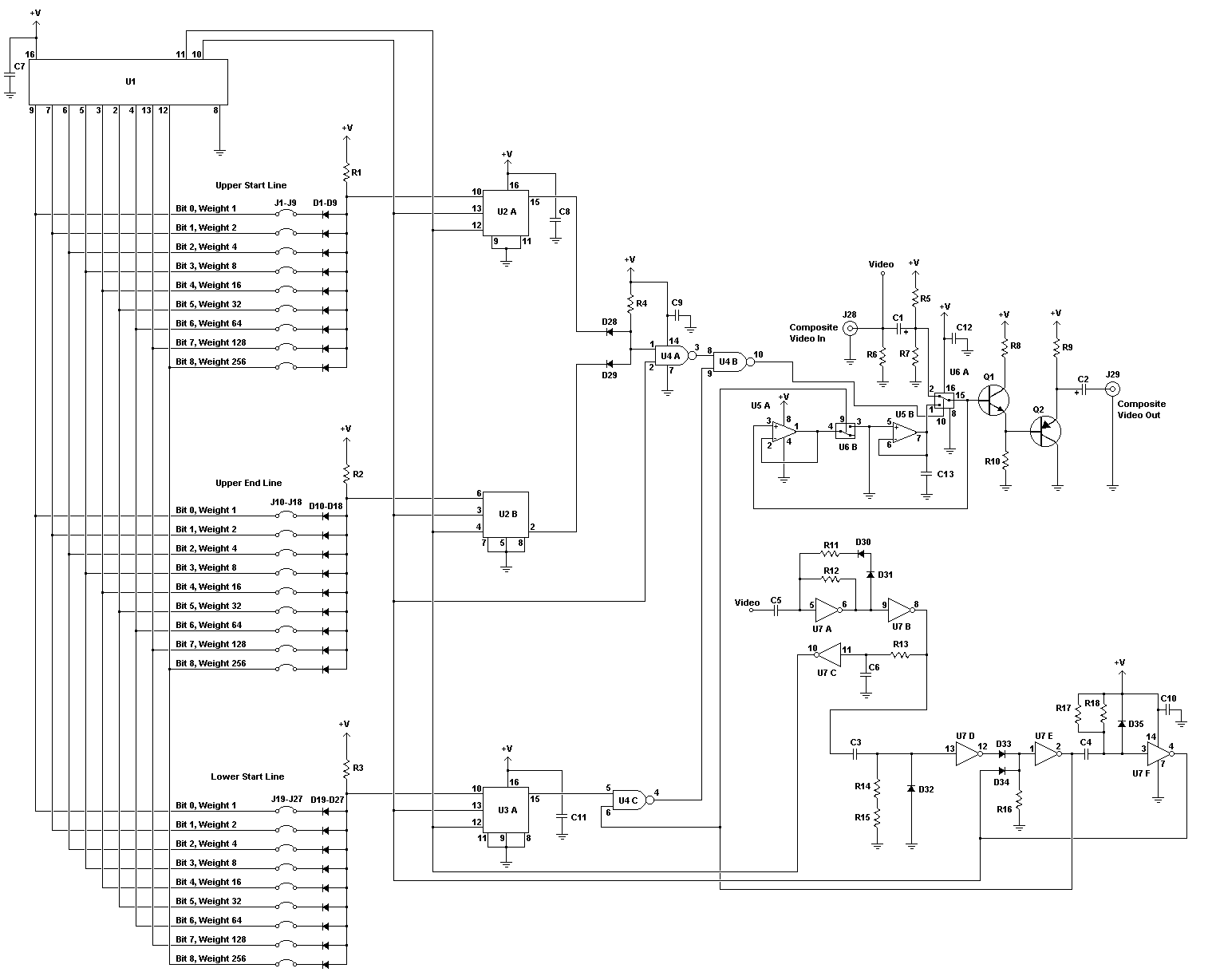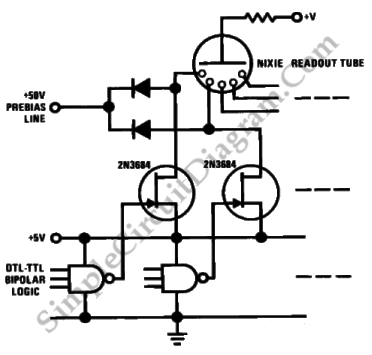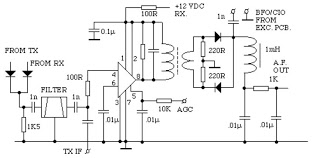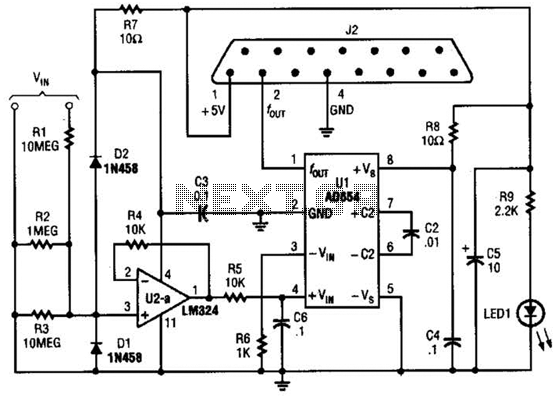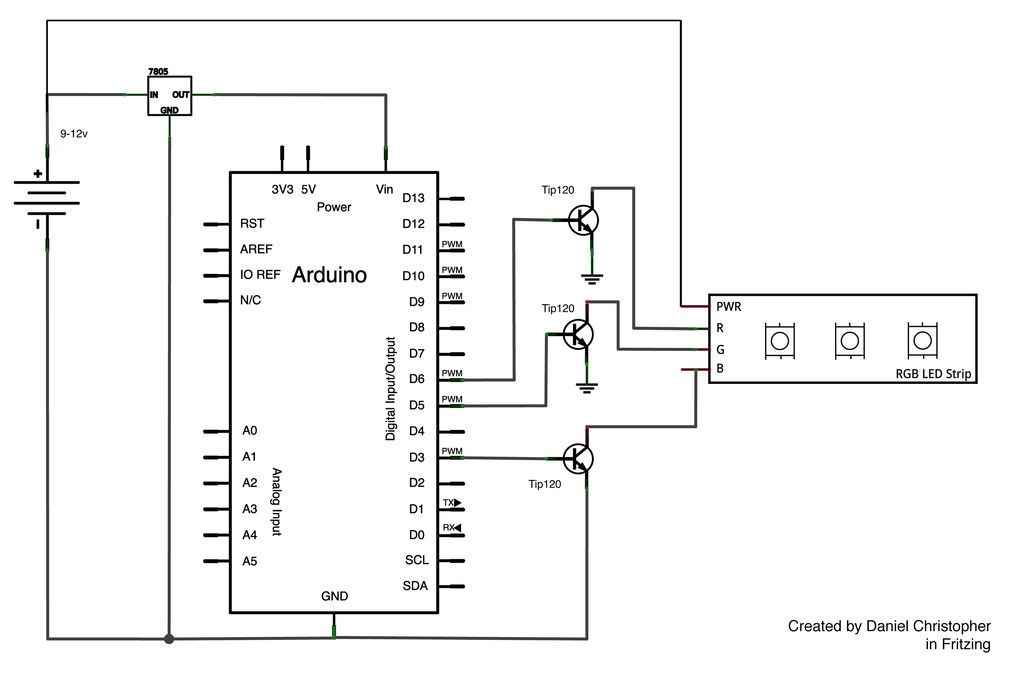
LED display driver circuit a
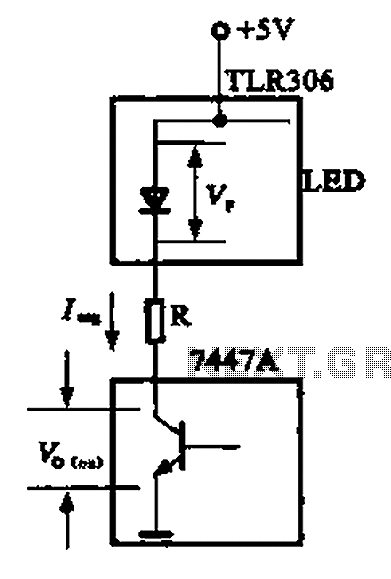
The circuit depicted is a large high-brightness LED driver designed to provide sufficient drive current, utilizing integrated circuits such as the 7447A or 74247. The digital display tube consists of eight light-emitting diodes, with seven dedicated to the digital display and one for the decimal point. The driver integrated circuits and the equivalent circuit of the light-emitting diode are illustrated in the display state. The circuit is powered by a 5V power supply, with the light-emitting diodes connected through a current-limiting resistor (R) to the collector of the driving transistor. For safety, the current through the light-emitting diodes is determined by selecting an appropriate current-limiting resistor. The maximum current for the light-emitting diodes is specified at 35 mA, but a margin is set to 30 mA. The forward voltage drop across the light-emitting diodes is 2V, and the driving transistor has a negligible voltage drop. The voltage drop across the current-limiting resistor is approximately 2.7V, leading to the calculation R = V / I = 2.7V / 30mA, resulting in a resistor value of 90Ω, with a preferred choice of 100Ω.
The LED driver circuit operates by controlling the current flowing through the LED array, ensuring optimal brightness while preventing damage due to excessive current. The integrated circuits 7447A or 74247 are commonly used in applications requiring a binary to seven-segment decoder/driver, making them suitable for driving the display. The arrangement of the LEDs allows for the representation of numerical values, with the additional LED serving as a decimal point for enhanced readability.
In this configuration, the 5V power supply is essential for powering the entire circuit. The current-limiting resistor is a critical component, as it regulates the current flowing through the LEDs. The selection of a 100Ω resistor provides a safe operating current of approximately 27 mA, which is well within the safe limits of the LEDs, ensuring longevity and consistent performance. Proper heat dissipation measures should also be considered, particularly for the driving transistor, to maintain its performance and prevent thermal failure.
In summary, this LED driver circuit is a well-designed solution for driving high-brightness LEDs in digital displays, offering a reliable operation with appropriate current control and safety measures in place. As shown in Figure is a large high-brightness LED driver circuit for a sufficient drive current, integrated circuits using a 7447A or 74247. Digital display tube has eight ligh t-emitting diodes, seven for digital display, a decimal point for displaying. Driver integrated circuits and light emitting diode equivalent circuit as shown in (a), in the display state. 5v power supply by light-emitting diodes and current limiting resistor R connected to the collector of the driving transistor pole.
For the safety circuit, the current to the light emitting diode is selected according to the desired current limiting resistor, the maximum current of the light emitting diode 35 mA, each having some margin is set to 30 mA, the light emitting diode drop removing 2V, and the driving transistor drop 0.V guide escape when current limiting resistor voltage drop of about 2.7 V, R V // 2.7 V/30 mA. R 90 0, and thus the election of La 100 Q.
The LED driver circuit operates by controlling the current flowing through the LED array, ensuring optimal brightness while preventing damage due to excessive current. The integrated circuits 7447A or 74247 are commonly used in applications requiring a binary to seven-segment decoder/driver, making them suitable for driving the display. The arrangement of the LEDs allows for the representation of numerical values, with the additional LED serving as a decimal point for enhanced readability.
In this configuration, the 5V power supply is essential for powering the entire circuit. The current-limiting resistor is a critical component, as it regulates the current flowing through the LEDs. The selection of a 100Ω resistor provides a safe operating current of approximately 27 mA, which is well within the safe limits of the LEDs, ensuring longevity and consistent performance. Proper heat dissipation measures should also be considered, particularly for the driving transistor, to maintain its performance and prevent thermal failure.
In summary, this LED driver circuit is a well-designed solution for driving high-brightness LEDs in digital displays, offering a reliable operation with appropriate current control and safety measures in place. As shown in Figure is a large high-brightness LED driver circuit for a sufficient drive current, integrated circuits using a 7447A or 74247. Digital display tube has eight ligh t-emitting diodes, seven for digital display, a decimal point for displaying. Driver integrated circuits and light emitting diode equivalent circuit as shown in (a), in the display state. 5v power supply by light-emitting diodes and current limiting resistor R connected to the collector of the driving transistor pole.
For the safety circuit, the current to the light emitting diode is selected according to the desired current limiting resistor, the maximum current of the light emitting diode 35 mA, each having some margin is set to 30 mA, the light emitting diode drop removing 2V, and the driving transistor drop 0.V guide escape when current limiting resistor voltage drop of about 2.7 V, R V // 2.7 V/30 mA. R 90 0, and thus the election of La 100 Q.

